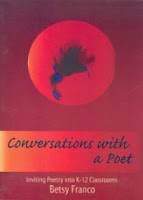
 Poet and anthologist Lee Bennett Hopkins published Pass the Poetry, Please! in 1972, the first major work about sharing poetry with young people followed by Kenneth Koch’s landmark book, Rose, Where Did You Get That Red? Teaching Great Poetry to Children in 1973.
Poet and anthologist Lee Bennett Hopkins published Pass the Poetry, Please! in 1972, the first major work about sharing poetry with young people followed by Kenneth Koch’s landmark book, Rose, Where Did You Get That Red? Teaching Great Poetry to Children in 1973. Lee has always been an amazing poet and anthologist, as well as a teacher, mentor and advocate for poetry for young people. He just celebrated a birthday and is looking forward to another publication this year, All the World’s a Stage, illustrated by Guy Billout and due out this summer (with Creative Editions in August). He tells me that this young adult anthology features an eclectic look at the Seven Ages of Man based on Shakespeare's monologue from “As You Like It.” Poems include works by Lewis Carroll, Ralph Fletcher, and Elizabeth Barrett Browning. Sounds wonderful, doesn’t it?
Contemporary Connections
Lee laid the path for other professional resource books to come—including supporting many of my efforts—like Poetry Aloud Here: Sharing Poetry with Children (the second edition is due out next month), Poetry People: A Practical Guide to Children’s Poets, The Poetry Teacher’s Book of Lists, and more. (Thank you, Lee!) Some of my other favorite poetry-teaching resource books include:
1. Barton, Bob and David Booth. Poetry Goes to School: From Mother Goose to Shel Silverstein.
2. Bauer, Caroline Feller. The Poetry Break: An Annotated Anthology with Ideas for Introducing Children to Poetry.
3. Booth, David and Moore, Bill. Poems Please! Sharing Poetry with Children.
4. Burkhardt, Ross. M. Using Poetry in the Classroom: Engaging Students in Learning.
5. Chatton, Barbara. Using Poetry Across the Curriculum.
 6. Fitch, Sheree and Swartz, Larry. The Poetry Experience; Choosing and Using Poetry in the Classroom.
6. Fitch, Sheree and Swartz, Larry. The Poetry Experience; Choosing and Using Poetry in the Classroom. 7. Franco, Betsy. Conversations With a Poet: Inviting Poetry into K-12 Classrooms.
8. Heard, Georgia. For the Good of the Earth and Sun; Teaching Poetry.
9. Heard, Georgia. Poetry Lessons to Meet the Common Core State Standards: Exemplar Poems with Engaging Lessons and Response Activities That Help Students Read, Understand and Appreciate Poetry.
10. Heitman, Jane. Rhymes and Reasons; Librarians and Teachers Using Poetry to Foster Literacy, Grades K-6.
11. Holbrook, Sara. Practical Poetry; A Nonstandard Approach to Meeting Content-Area Standards.
12. Holbrook, Sara and Salinger, Michael. Outspoken: How to Improve Writing and Speaking Through Poetry Performance.
 13. Israel, Susan E. ed. Poetic Possibilities; Using Poetry to Enhance Literacy Learning.
13. Israel, Susan E. ed. Poetic Possibilities; Using Poetry to Enhance Literacy Learning. 14. Janeczko, Paul B. Reading Poetry in the Middle Grades: 20 Poems and Activities that Meet the Common Core Standards and Cultivate a Passion for Poetry.
15. Kennedy, X. J. and Kennedy, D. Knock at a Star.
16. Livingston, Myra Cohn. The Child as Poet: Myth or Reality?
17. Livingston, Myra Cohn. Climb into the Bell Tower: Essays on Poetry.
18. Livingston, Myra Cohn. Poem-Making.
19. McClure, Amy. Sunrises and Songs; Reading and Writing Poetry in the Elementary Classroom.
20. O’Connor, John S. Wordplaygrounds; Reading, Writing, and
Performing Poetry in the English Classroom.
 21. Partington, Richie. I Second that Emotion: Sharing Children’s and Young Adult Poetry: A 21st Century Guide for Teachers and Librarians.
21. Partington, Richie. I Second that Emotion: Sharing Children’s and Young Adult Poetry: A 21st Century Guide for Teachers and Librarians. 22. Sloan, Glenna. Give Them Poetry; A Guide for Sharing Poetry with Children K-8.
23. Stanley, Nile. Creating Readers with Poetry.
24. Tiedt, Iris McClellan. Tiger Lilies, Toadstools, And Thunderbolts: Engaging K-8 Students With Poetry.
And of course there are many wonderful blogs and websites that are jam-packed with guidance on sharing poetry with kids, too.
Also, check out these brand new teaching resources from poet David L. Harrison, too:
 Let's Write This Week with David Harrison
Let's Write This Week with David HarrisonThe kit includes twenty 5-minute DVD tips on writing (featuring Harrison), a teacher's guide co-authored with Laurie Edmondson (interim director of the school of education and child development at Drury), 20 copies of a student writing journal, and three of Harrison’s trade books (poetry, fiction, and nonfiction) used as examples in the classroom activities and take home suggestions written by Edmondson all tied together with CCSS connections.
Learning Through Poetry
His second series provides strategies that include phonemic matching, phonemic isolation, phonemic blending, phonemic substitution, and phonemic segmentation. Take-home activities are included to encourage linguistic interaction with friends and family members, which is especially useful for English language learners and their families. The titles include Short Vowels, Long Vowels, Rimes, Consonants, and Consonant Blends and Digraphs. These books feature digital resources that include activity pages, poems, family letters, and an audio recording of each poem (96 in all). This resource also supports the Common Core State Standards.
He'll be launching these at IRA this weekend! Meanwhile, here's a clever poem poster (poem by Harrison, poster by Highlights) that is hot-off-the-press. Enjoy!
 |
| Used by permission of Highlights for Children, Inc. |
Posting by Sylvia M. Vardell © 2013. All rights reserved.
Image credits: Image credits: www.barnesandnoble.com;books.google.com;BiblioObscura;Amazon

Thank you, Sylvia! I appreciate all you do for poetry and poets. I look forward to your blogs and am eager to see you again at IRA.
ReplyDeleteDavid